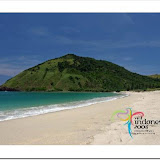
The islands of the Komodo Dragon: Rinca & Komodo Islands are part of the complex of 175 islands (about 90% unhabitant), situated 200 nautical miles east of Bali, between the islands of Flores and Sumbawa. Both above and below the sea Komodo represents a unique range of geological and biological diversity. On shore it is an amazing museum diorama of the Mesozoic era dry tundra and reptilian supremacy. Komodo's symbol of international fame its dragons, the world's largest living lizard.
In the sea it's vibrant color and exotic life will enchant divers and snorkelers alike as endless schools of fish ride the waterways rushing up from deep sea vents, below them the seabed is covered with a thick carpet of florescent corals and marine invertebrates, an underwater photographers paradise.
The waters that surround the island are turbulent and teeming with unparalled marine life. A marine reserve has recently been established and this reserve is largely undocumented and remains unexplored. Komodo National Park was established in 1980. It was declared as a Man and Biosphere Reserve and a World Heritage Site in 1986. KNP includes three major islands - Komodo, Rinca and Padar and numerous smaller islands together totaling 41,000 ha of land contains 132,000 ha of marine waters.
The corals in Komodo National park are pristine, with Mantas, sharks, turtles, dolphins, dugong, many pelagics, to the tiny pygmy seahorses, nudibranchs, frog fish, you name it we've got it. The sites vary from gentle easy coral slopes to heart pounding adrenalin rides, from the warm waters of the Flores Sea in the north to the chillier waters down south in the Indian Ocean, the underwater terrain is so varied with sheer cliff walls, pinnacles, sandy flat bottoms, underwater plateaus, slopes, caves, swim-throughs, channels, all with varying colours, sizes and types of coral both hard and soft.
DIVE SITES:
Bidadari Island
Angel Steps, huge towers of stone, encrusted with hard and soft corals, covered in nudibranchs, small caves and overhangs make this a very interesting and beautiful site, Dusky sharks, humphead parrot fish are among the bigger creatures we see here. Cathedral Coral, a gentle slope covered with table corals of every colour and schooling fish, a towering spire of coral with a small cave at it's base is the home to some huge lobsters.
Sabolon
*Sabolon kecil a slope on the east side of this tiny island, with two underwater mounds at the southern end with fields of garden eels and sea pens, schools of round bat fish are often seen coming quite close for some nice photography.
*Sabolon Besar steep slopes off the southern and western sides of the bigger island, fabulous coral coverage and a good chance of spotting Scorpion leaf fish.
*Sebayur kecil walls and slopes of every kind of coral you can imagine, wide variety of marine life to be seen at this site, mantas often seen.
*Tatawa Besar slope with soft coral garden changing to hard coral along the slope, lots of shoaling fish, rainbow runners, fuseliers and often turtles and black tip sharks.
*Tatawa Kecil (current city) as the name implies, this site is washed by very strong currents, which is why this site is among the many world class sites in the Komodo National Park, schools of pelagic fish patrol the waters, best dived at slack tide.
Batu Bolong
A little further west from current city a small rock outcrop with a hole through it is the surface mark of another world class site, only to be dived at slack tide or with a current not long from stopping or starting to run, these giant slabs of rock which disappear into the depths are an amazing sight to see, covered with every form of marine life and patrolled by giant trevally, Napoleon Wrasse, sharks and turtles with schools of barracuda sweeping in to check out the divers.
Diving the Komodo National Park provides some fantastic conditions:
*WATER TEMPERATURE: 20 - 28 Degrees Celsius (68-85 F) , cooler water is experienced on the southern sites. Full 3mm wetsuit & hood is recommended. More active people will prefer a sports suit in northern sites.
*VISIBILITY: 10 - 50M year round. Traditionally clearer water on northern sites.CURRENT: Komodo experiences a strong tidal flow. Not all sites are affected by current. Drift diving is excellent, however during spring tides some sites are impossible to dive. Particular attention is placed on diving the correct sites at the most suitable time to ensure optimum conditions, in accordance with the preferences of the group.
*NIGHT DIVING: The night diving in Komodo is breathtaking. The sheer beauty, color and diversity of life makes it a must see for all divers.
*WALLS: There are numerous walls to choose from. Both drift and static wall dives are offered.
*CANYONS: Huge chasms drop thousands of meters, fringed by extraordinary coral gardens.
*CRITTERS: Found in all locations, however we do offer special sites for encountering unusual marine species.
*OTHERS: Seamounts, fringing reefs, gutters, muck, and sandy locations are also found in the archipelago.
Getting There
By daily flights from: Bali - Labuan Bajo/Komodo Airport - Bali (each 1.5 hours)
Where To Stay
You can contact the above tour operators for more information. You can also plan to stay in Bali, and spend a whole day for visiting Komodo Island.
Moving Around
On foot. If you join a tour, the tour will see to everything? including the transportation.
Dining Guide
Traditional restaurants and small cafes.
Souvenir Tips
Wooden carving resembling komodo and other animals.
Other Things to See or Do
*Fishing
*Snorkeling in Komodo has one of the world's most famous snorkel sites (Pink Beach)
*Dragon walks
*Nature walks
*Hiking
*Beach-combing.

Travel Tips
*Guide Book : Diving Indonesia (a guide to the world's greatest diving), Periplus Action Guide, Kal Muller.
* More Information about Diving in Komodo Islands you can contact: Adventure Indonesia, Jakarta Office-Wisma 31 Kemang, 3rd Floor, Jl Raya Kemang 31, Jakarta 12730. Phone: 62-21-7182250, 7182256, Fax: 62-21-7180438.













